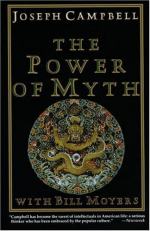
|
| Name: _________________________ | Period: ___________________ |
This test consists of 15 multiple choice questions and 5 short answer questions.
Multiple Choice Questions
1. What complaint do Campbell and Moyers repeat in Chapter 5?
(a) There are too many myths in our society.
(b) Schools do not teach enough mythology.
(c) Modern society does not have adequate myths for the youth.
(d) Youth no longer believes in myths.
2. What is God in the Oriental culture?
(a) Survivor of the universe
(b) Keeper of the universe
(c) Creator of the universe
(d) Manifestation of the universe
3. Which of the following can be said that occurs in the stories of Jesus Christ, Buddha and Moses?
(a) Common elements
(b) Similar features
(c) Exact same story, different geographical areas
(d) No commonalities
4. An indication of how Western culture might have evolved had Hebrew mythology not survived can be seen in ___________________________.
(a) religions of India
(b) Asian religions
(c) religions of Africa
(d) religions of South America
5. What is a powerful symbol that appears in all religions and cultures?
(a) Cross
(b) Circle
(c) Square
(d) Star
6. How does Campbell indicate that role models for society are created?
(a) Following the rules of the heros
(b) Surviving the evildoers
(c) Heroes overcoming challenges
(d) The writings from the Gods
7. What does Campbell indicate will emerge to replace the old traditional mythologies?
(a) Global mythology
(b) Galactic mythology
(c) Goddess mythology
(d) Stable mythology
8. Which of the following is immortal and voluntarily participates in the sorrows of the world?
(a) Bodhisattva
(b) Nirvana
(c) Jesus Christ
(d) Tibetan Buddhist Monks
9. How do the troubadours describe love?
(a) The means
(b) The goal
(c) The ideal
(d) The only
10. Who has never uttered a word of recrimination or complaint toward their persecutors in the Chinese government?
(a) Jesus Christ
(b) Dalai Lama
(c) Buddhist monks
(d) Moses
11. When, approximately, did the suppression of the Goddess religions come about?
(a) Fifth Millennium BC
(b) Fourth Millennium BC
(c) Seventh Millennium BC
(d) Third Millenium BC
12. What does Campbell indicate the concept of romantic love stresses in Western culture?
(a) Preeminence of the individual's experience
(b) Chaos of society
(c) Constraints of the society
(d) Demands of society
13. Which type of societies and cultures identified with the Goddess?
(a) Those in the river valleys
(b) Those with the most power and knowledge
(c) Those in the mountains
(d) Those near the ocean
14. What influence does Campbell indicate leads to the reemergence of the female figure in the Christian religion?
(a) Greek
(b) Romans
(c) Roman Catholic church
(d) Hebrew people
15. What is lacking in relation to the figures unearthed in Europe dating back to the Neolithic period?
(a) Fertility ritual figures
(b) Male counterparts
(c) Worship figures
(d) Female figures
Short Answer Questions
1. What does Jung say about religion?
2. What type of teacher was Campbell that he recounts in Chapter 8?
3. Which of the following was not a major river which played an important part in the development of societies and cultures?
4. What does Campbell indicate is identified as the natural choice for supreme being?
5. According to Campbell, infidelity goes against which of the following?
|
This section contains 484 words (approx. 2 pages at 300 words per page) |

|




